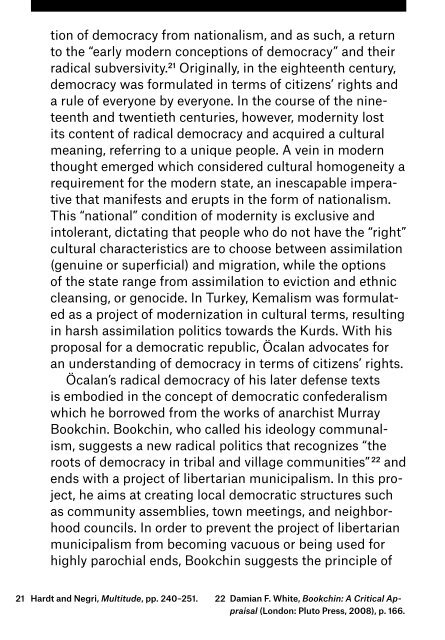Stateless Democracy
1RHiH4Y
1RHiH4Y
Create successful ePaper yourself
Turn your PDF publications into a flip-book with our unique Google optimized e-Paper software.
tion of democracy from nationalism, and as such, a return<br />
to the “early modern conceptions of democracy” and their<br />
radical subversivity. 21 Originally, in the eighteenth century,<br />
democracy was formulated in terms of citizens’ rights and<br />
a rule of everyone by everyone. In the course of the nineteenth<br />
and twentieth centuries, however, modernity lost<br />
its content of radical democracy and acquired a cultural<br />
meaning, referring to a unique people. A vein in modern<br />
thought emerged which considered cultural homogeneity a<br />
requirement for the modern state, an inescapable imperative<br />
that manifests and erupts in the form of nationalism.<br />
This “national” condition of modernity is exclusive and<br />
intolerant, dictating that people who do not have the “right”<br />
cultural characteristics are to choose between assimilation<br />
(genuine or superficial) and migration, while the options<br />
of the state range from assimilation to eviction and ethnic<br />
cleansing, or genocide. In Turkey, Kemalism was formulated<br />
as a project of modernization in cultural terms, resulting<br />
in harsh assimilation politics towards the Kurds. With his<br />
proposal for a democratic republic, Öcalan advocates for<br />
an understanding of democracy in terms of citizens’ rights.<br />
Öcalan’s radical democracy of his later defense texts<br />
is embodied in the concept of democratic confederalism<br />
which he borrowed from the works of anarchist Murray<br />
Bookchin. Bookchin, who called his ideology communalism,<br />
suggests a new radical politics that recognizes “the<br />
roots of democracy in tribal and village communities” 22 and<br />
ends with a project of libertarian municipalism. In this project,<br />
he aims at creating local democratic structures such<br />
as community assemblies, town meetings, and neighborhood<br />
councils. In order to prevent the project of libertarian<br />
municipalism from becoming vacuous or being used for<br />
highly parochial ends, Bookchin suggests the principle of<br />
confederalism as “a network of administrative councils<br />
whose members or delegates are elected from popular<br />
face-to-face democratic assemblies, in the various villages,<br />
towns, and even neighborhoods of large cities.” 23 For Bookchin,<br />
confederalism as a principle of social organization<br />
“is a way of democratizing that interdependence without<br />
surrendering to the principle local control.” 24<br />
Öcalan, influenced by the ideas of Bookchin, developed<br />
a similar understanding of that principle of confederalism.<br />
In parallel to his historical analysis of civilization based on<br />
the critique of the state, Öcalan condemned the failure of<br />
real socialism and national liberation movements, which<br />
he considered to be trapped in the ideas of the state and<br />
state-making. Alternatively, he elaborated on the protracted<br />
effects of the Neolithic society whose communal values<br />
could not have been completely destroyed by the development<br />
of hierarchical society built upon the state. Those<br />
communal values — summarized as socialization based on<br />
gender and life compatible with nature and society, rooted<br />
in communality and solidarity — underlie his conception of<br />
democracy in the form of democratic confederalism.<br />
On the basis of those values, the project of democratic<br />
confederalism is organized at four levels. At the bottom,<br />
there are the communes in the village and districts, which<br />
are interrelated at the levels of towns, cities, and regions.<br />
Then follows the organization of the social groups such as<br />
the women, youth, and others. Another level of organization<br />
occurs at the cultural scale in terms of organization for<br />
different ethnic-religious-cultural identities. The fourth and<br />
final level is the level of civil society organizations. In this<br />
sense, democratic confederalism, based on kinds of assemblies<br />
at village-districts, city and regional levels, refers to the<br />
172–173<br />
21 Hardt and Negri, Multitude, pp. 240–251. 22 Damian F. White, Bookchin: A Critical Appraisal<br />
(London: Pluto Press, 2008), p. 166.<br />
23 Ibid., p. 166. 24 Murray Bookchin, From Urbanization to<br />
Cities: Toward a New Politics of Citizenship<br />
(London: Cassell, 1996), p. 298.



